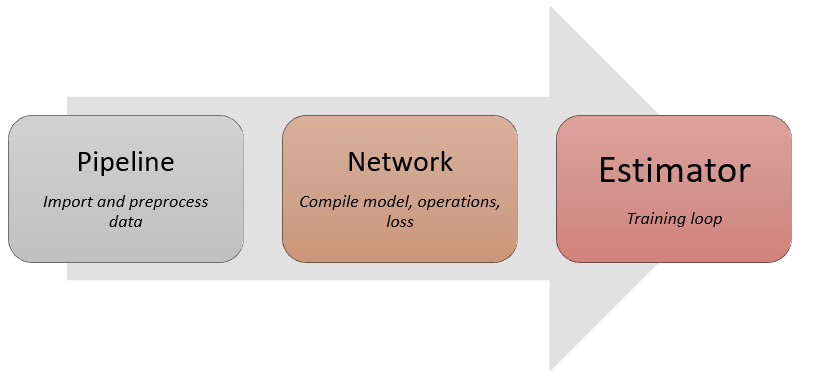Three main APIs¶
All deep learning training workflows involve the following three essential components, each mapping to a critical API in FastEstimator.
Data pipeline: extracts data from disk/RAM, performs transformations. ->
fe.PipelineNetwork: performs trainable and differentiable operations. ->
fe.NetworkTraining loop: combines the data pipeline and network in an iterative process. ->
fe.Estimator
Any deep learning task can be constructed by following the 3 main steps:

Image Classification Example¶
Step 1 - Pipeline¶
We use FastEstimator dataset API to load the MNIST dataset. Please check out tutorial 2 for more details about the dataset API. In this case our data preprocessing involves:
- Expand image dimension from (28,28) to (28, 28, 1) for convenience during convolution operations.
- Rescale pixel values from [0, 255] to [0, 1].
Please check out tutorial 3 for details about Operator and tutorial 4 for Pipeline.
import fastestimator as fe
from fastestimator.dataset.data import mnist
from fastestimator.op.numpyop.univariate import ExpandDims, Minmax
train_data, eval_data = mnist.load_data()
pipeline = fe.Pipeline(train_data=train_data,
eval_data=eval_data,
batch_size=32,
ops=[ExpandDims(inputs="x", outputs="x"), Minmax(inputs="x", outputs="x")])
Step 2 - Network¶
The model definition can be either from tf.keras.Model or torch.nn.Module, for more info about network definitions, check out tutorial 5. The differentiable operations during training are listed as follows:
- Feed the preprocessed images to the network and get prediction scores.
- Calculate
CrossEntropy(loss) between prediction scores and ground truth. - Update the model by minimizing
CrossEntropy.
For more info about Network and its operators, check out tutorial 6.
from fastestimator.architecture.tensorflow import LeNet
# from fastestimator.architecture.pytorch import LeNet # One can also use a pytorch model
from fastestimator.op.tensorop.loss import CrossEntropy
from fastestimator.op.tensorop.model import ModelOp, UpdateOp
model = fe.build(model_fn=LeNet, optimizer_fn="adam")
network = fe.Network(ops=[
ModelOp(model=model, inputs="x", outputs="y_pred"),
CrossEntropy(inputs=("y_pred", "y"), outputs="ce"),
UpdateOp(model=model, loss_name="ce")
])
Step 3 - Estimator¶
We define the Estimator to connect the Network to the Pipeline, and compute accuracy as a validation metric. Please see tutorial 7 for more about Estimator and Traces.
from fastestimator.trace.metric import Accuracy
from fastestimator.trace.io import BestModelSaver
import tempfile
traces = [Accuracy(true_key="y", pred_key="y_pred"),
BestModelSaver(model=model, save_dir=tempfile.mkdtemp(), metric="accuracy", save_best_mode="max")]
estimator = fe.Estimator(pipeline=pipeline,
network=network,
epochs=2,
traces=traces)
Start Training¶
estimator.fit()
______ __ ______ __ _ __
/ ____/___ ______/ /_/ ____/____/ /_(_)___ ___ ____ _/ /_____ _____
/ /_ / __ `/ ___/ __/ __/ / ___/ __/ / __ `__ \/ __ `/ __/ __ \/ ___/
/ __/ / /_/ (__ ) /_/ /___(__ ) /_/ / / / / / / /_/ / /_/ /_/ / /
/_/ \__,_/____/\__/_____/____/\__/_/_/ /_/ /_/\__,_/\__/\____/_/
FastEstimator-Start: step: 1; num_device: 0; logging_interval: 100;
FastEstimator-Train: step: 1; ce: 2.325205;
FastEstimator-Train: step: 100; ce: 0.37162033; steps/sec: 161.0;
FastEstimator-Train: step: 200; ce: 0.24027318; steps/sec: 166.53;
FastEstimator-Train: step: 300; ce: 0.042502172; steps/sec: 160.22;
FastEstimator-Train: step: 400; ce: 0.08067161; steps/sec: 160.19;
FastEstimator-Train: step: 500; ce: 0.0573852; steps/sec: 149.4;
FastEstimator-Train: step: 600; ce: 0.0157291; steps/sec: 146.06;
FastEstimator-Train: step: 700; ce: 0.21018827; steps/sec: 140.01;
FastEstimator-Train: step: 800; ce: 0.008484628; steps/sec: 135.1;
FastEstimator-Train: step: 900; ce: 0.02928259; steps/sec: 128.3;
FastEstimator-Train: step: 1000; ce: 0.061196238; steps/sec: 126.4;
FastEstimator-Train: step: 1100; ce: 0.06762987; steps/sec: 120.72;
FastEstimator-Train: step: 1200; ce: 0.0072296523; steps/sec: 118.11;
FastEstimator-Train: step: 1300; ce: 0.08244678; steps/sec: 110.16;
FastEstimator-Train: step: 1400; ce: 0.07375234; steps/sec: 105.76;
FastEstimator-Train: step: 1500; ce: 0.03207487; steps/sec: 104.01;
FastEstimator-Train: step: 1600; ce: 0.1325811; steps/sec: 104.97;
FastEstimator-Train: step: 1700; ce: 0.2333475; steps/sec: 99.21;
FastEstimator-Train: step: 1800; ce: 0.081265345; steps/sec: 101.39;
FastEstimator-Train: step: 1875; epoch: 1; epoch_time: 17.21 sec;
FastEstimator-BestModelSaver: Saved model to /var/folders/lx/drkxftt117gblvgsp1p39rlc0000gn/T/tmplq_y8tyg/model_best_accuracy.h5
FastEstimator-Eval: step: 1875; epoch: 1; ce: 0.05035614; accuracy: 0.9828; since_best_accuracy: 0; max_accuracy: 0.9828;
FastEstimator-Train: step: 1900; ce: 0.24747448; steps/sec: 100.72;
FastEstimator-Train: step: 2000; ce: 0.056484234; steps/sec: 169.42;
FastEstimator-Train: step: 2100; ce: 0.1583787; steps/sec: 186.35;
FastEstimator-Train: step: 2200; ce: 0.004822081; steps/sec: 179.8;
FastEstimator-Train: step: 2300; ce: 0.027388994; steps/sec: 180.22;
FastEstimator-Train: step: 2400; ce: 0.017995346; steps/sec: 183.84;
FastEstimator-Train: step: 2500; ce: 0.0071977032; steps/sec: 184.27;
FastEstimator-Train: step: 2600; ce: 0.034278065; steps/sec: 182.51;
FastEstimator-Train: step: 2700; ce: 0.045357186; steps/sec: 181.42;
FastEstimator-Train: step: 2800; ce: 0.057187617; steps/sec: 182.88;
FastEstimator-Train: step: 2900; ce: 0.04257428; steps/sec: 178.63;
FastEstimator-Train: step: 3000; ce: 0.26984444; steps/sec: 167.96;
FastEstimator-Train: step: 3100; ce: 0.026010124; steps/sec: 166.83;
FastEstimator-Train: step: 3200; ce: 0.03834851; steps/sec: 161.82;
FastEstimator-Train: step: 3300; ce: 0.01365272; steps/sec: 166.79;
FastEstimator-Train: step: 3400; ce: 0.015053293; steps/sec: 164.75;
FastEstimator-Train: step: 3500; ce: 0.0041770767; steps/sec: 163.45;
FastEstimator-Train: step: 3600; ce: 0.0006832063; steps/sec: 162.57;
FastEstimator-Train: step: 3700; ce: 0.015146113; steps/sec: 158.26;
FastEstimator-Train: step: 3750; epoch: 2; epoch_time: 11.0 sec;
FastEstimator-BestModelSaver: Saved model to /var/folders/lx/drkxftt117gblvgsp1p39rlc0000gn/T/tmplq_y8tyg/model_best_accuracy.h5
FastEstimator-Eval: step: 3750; epoch: 2; ce: 0.0408412; accuracy: 0.9875; since_best_accuracy: 0; max_accuracy: 0.9875;
FastEstimator-Finish: step: 3750; total_time: 30.16 sec; model_lr: 0.001;
Inferencing¶
After training, we can do inferencing on new data with Pipeline.transform and Netowork.transform. Please checkout tutorial 8 for more details.
import numpy as np
data = eval_data[0]
data = pipeline.transform(data, mode="eval")
data = network.transform(data, mode="eval")
print("Ground truth class is {}".format(data["y"][0]))
print("Predicted class is {}".format(np.argmax(data["y_pred"])))
img = fe.util.ImgData(x=data["x"])
fig = img.paint_figure()
Ground truth class is 7 Predicted class is 7